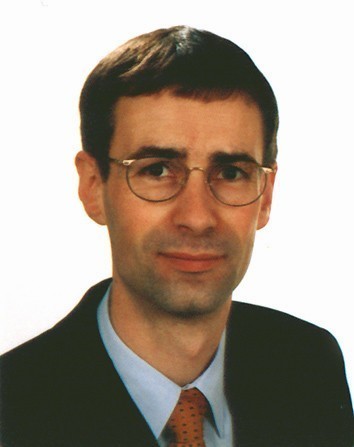2003 Hans and Marlies Zimmer International Scholar

Dr. Gunther Wittstock
Dr. Gunther Wittstock is professor of Physical Chemistry at the Carl von Ossietzky University of Oldenburg in Oldenburg, Lower Saxony, Germany. He was born and raised in Schwerin, Mecklenburg-Vorpommern, Germany. After completing the school of education with the Abitur and military service, he studied Chemistry at the University of Leipzig from 1986 to 1991. He joined the curriculum program of Physical and Theoretical Chemistry and prepared his Diploma thesis in the Institute of Analytical Chemistry on the adsorption and electrochemistry of ubiquinones at electrodes under the supervison of Hendrik Emons.
Prof. Wittstock conducted his Ph.D. project under the supervision of Hendrik Emons and Gerhard Werner at the University of Leipzig with funding from the German National Merit Foundation. During this period he worked with Professors William Heineman, Thomas Ridgway, and Brian Halsall at the University of Cincinnati for a total of eleven months, where he assembled a scanning electrochemical microscope (SECM) - an instrument which continues to fascinate him today. His Ph.D. dissertation, completed in 1994, described the application of the instrument for the evaluation of sensor components.
As a postdoc Professor Wittstock worked at the Technical University of Munich with Hanns-Ludwig Schmidt and Wolfgang Schuhmann where he became interested in probe-induced modification of surfaces.
Upon returning to Leipzig, he joined the group of X-ray and Electron Spectroscopy/Surface Analysis led by Professor Rüdiger Szargan at the Wilhelm Ostwald Institute for Physical and Theoretical Chemistry of the University of Leipzig. During that time he concentrated on the application of x-ray photoelectron spectroscopy and synchrotron radiation photoelectron spectroscopy for the structural investigation of monolayers formed by various heterocyclic compounds on sulphide mineral surfaces within a project of the European Community. After completion of the project he continued as a Scientific Assistant in the same group with his team studying local modification of organic thin films and spatially resolved reactivity characterization of patterned surfaces using SECM and electrochemical scanning tunneling microscopy.
Following the habilitation in 2001, he received calls to the Justus Liebig University Gießen and the Carl von Ossietzky University Oldenburg. In October 2001 he became full professor (C4) of Physical Chemistry at the University of Oldenburg. His current research interests are design of functional organic thin layers on solid supports for various applications such as sensors and sensor arrays, microelectrochemistry including SECM and numerical simulations, organic-inorganic hybrid materials, scanning probe techniques and the combination of optical and microelectrochemical detection and excitation principles.
Gunther Wittstock is married to Dr. Marion Schaefer and has one daughter.
Patterned Organic Thin Films: Reactivity Imaging from Micrometer towards Nanometer Size Regimes with Scanning Electrochemical Microscopy
Gunther Wittstock, Carl von Ossietzky University Oldenburg, Department of Chemistry and Institute of Chemistry and Biology of the Marine Environment, D-26111 Oldenburg, Germany
Scanning electrochemical microscopy (SECM) has become an indispensable tool for the characterization of reactivities at interfaces. Among the reactions that have been studied by this technique are reactions of immobilized enzymes and other biomolecules [1]. The analysis is based on the detection of redox active species generated by an immobilized enzyme though conversion at the scanning ultramicroelectrode (UME). This mode is called generation-collection mode. Alternatively one can use the UME to locally produce a cofactor for an enzymatic reaction and observe the cofactor consumption of the enzyme by a change of the amperometric current at the UME (feedback mode).
In addition to localized analysis SECM instruments can be used as tools for microstructuring [2]. The special advantage of such surface modification protocols are twofold: They can be applied in aqueous buffers, an environment that maintains the activity of delicate biochemical surface layers. By switching between microstructuring and reactivity imaging the success of individual preparation steps can be analysed forming the basis for the rational optimization of such processes.
Self-assembled monolayers (SAM) of alkanethiolates on gold can form a passivating inert film. By patterning such layers, a surface template can be formed into which enzymatically active layers can be immobilized. Patterned SAMs have been prepared by microcontact printing [3] and localized electrochemical desorption using SECM. By combination of both approaches complex patterns become available that contain two or more enzymes. Reaction chains and cofactor recycling between different active regions can be studied as a function of the pattern layout at such specimens.
The experiments described above have been performed in the micrometer range, i.e. the UME electrode used as local probe has diameters of 10-25 micrometer. Its extension limits the lateral resolution to about the same size. A much higher lateral resolution is needed for several application like the investigation of fuel cell catalysts. Such experiments require smaller probes, still having a suitable geometry. Rather extensive experiments in conjunction with digital simulations using the boundary element method (BEM) allowed to optimize an etching and coating procedure to give nanoelectrodes suitable for such experiments. Furthermore, SECM experiments in the nanometer regime require a mechanisms for guiding the UME in constant distance over the specimen surface because the surface roughness it at least in the size regime of the UME itself. In our setup the mechanism of a scanning tunneling microscope (ECSTM) is used to obtain topographic information of the sample. This information is then used position the UME in the SECM experiment. First experiments confirm the overall success of the strategies but also highlight some fundamental problems.
- G. Wittstock, Fresenius J. Anal. Chem. 2001, 370, 303-315.
- T. Wilhelm, G. Wittstock; Electrochim. Acta 2001, 47, 275-281.
- T. Wilhelm, G. Wittstock, Langmuir 2002, 18, 9486-9493.